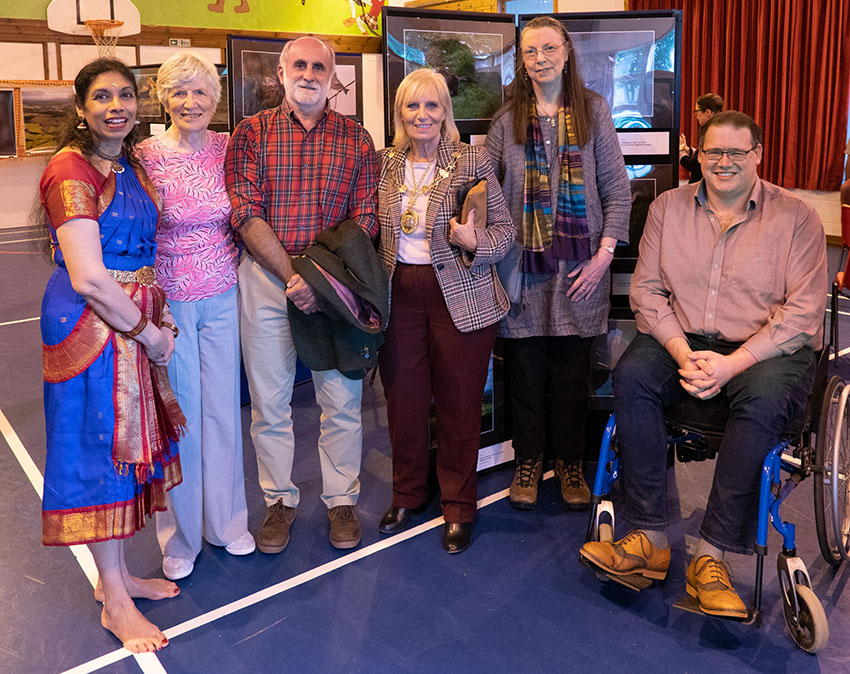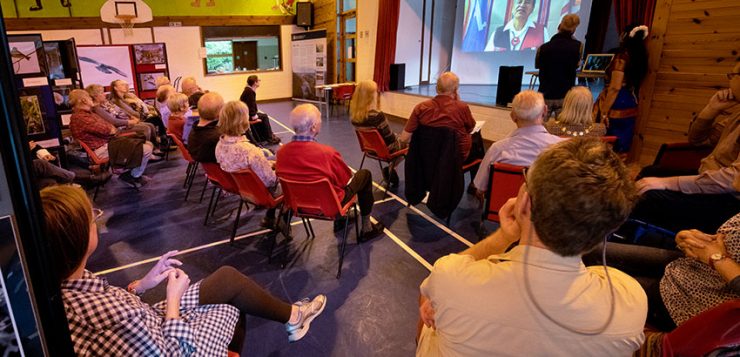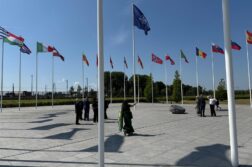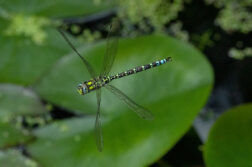On Saturday 1st September, 2018, as part of the first event for the Heartstone ‘Cura’ project, an extraordinary connection took place from Kiltarlity Village Hall in the Highlands of Scotland, to the Cheyenne Nation, the famed Native Americans who are based in and around Yellowstone National Park, Montana, USA.

The centrepiece for the event was the exhibition of photographs of the natural environment of Glen Convinth, the area surrounding Kiltarlity, together with a storytelling performance by Sitakumari, volunteer hosts from the local community who had been involved in the production of the Glen Convinth books and scientists linked to the creatures and locations in the images.
But the main draw for the event was without doubt the unique contact with the Cheyenne, one of the most well-known Native American nations, famous for their role in history and for whom the natural world is a key part of their culture and identity.
As part of forging the link between the two communities, the ‘Glen Convinth’ books were signed by Drew Hendry, MP, Fergus Ewing, MSP, the Provost Helen Carmichael, the Ward councillors, the local Community Council and the guest speakers who were there for the event, and sent post the event to the Cheyenne as a gift from the area.

The ‘Glen Convinth’ books are part of Heartstone’s ‘Without Frontiers’ project and have led to this next phase of the project in which, for the first time, they have become the mechanism to reach out to other people across the world, who similarly care about their environment and where ‘story’ has cultural significance. The first contact to be made was at this event with the Vice President of the Cheyenne Nation, Conrad Fisher, who is also the Custodian of the Nation’s stories.

The exhibition featured just some of the images from the ‘Glen Convinth’ collection, all taken by Nick Sidle, which tell a story, from the smallest insects to the largest mammals and birds. Raptors, badgers, pine martens, rare species such as the Hawfinch and Narrow Bordered Bee Hawkmoth and a raging hill fire were all included demonstrating both the richness of the environment and also some of the threats it faces. As is always the case with Nick’s photos, none of the images were staged, posed or manipulated, all have been produced in the area in real time, with the most important linking feature being breathtaking imagery, drawing the audience into the subject and the habitat to see it from a new perspective.
Special presenters brought the science and conservation challenges behind the exhibition’s subjects ‘to life’ including experts from Butterfly & Moth Conservation, the Forestry Commission, Highland Biological Recording Group and the Scottish Wildlife Trust.



Stephen Moran, Highland Biological Recording Group said:
“The diversity of the attendees was as rich in some ways as the biodiversity of Glenconvinth. I fielded all sorts of questions from all ages and enjoyed the wide ranging conversations and views on offer. Folk were (very understandably in my view) fascinated by the view through the microscope of the variety and complexity of shapes, sizes, adaptations and lifestyles shown even in one small group of insects. It was a good opportunity to emphasise the importance of being aware of how little we really know of the environment that we live in and how we can all make a contribution to finding out more.”

Stuart Bence, from Butterfly & Moth Conservation, is currently undertaking research on the Pine-tree lappet moth, which is being studied extensively because of its potential threat to the Scots pine and other tree species. He was able to bring his own fascination of moths, together with a few live examples, demonstrating their many varieties and colours but also an explanation of the crucial role they play in the food chain, to the exhibition. Butterfly & Moth Conservation have assisted Heartstone over several years for the butterfly and moth sections of ‘Without Frontiers’.


Giles Drake-Brockman, the Forestry Commission’s Manager for Highland, was able to bring his extensive knowledge of the woodlands across the region taking audiences further into understanding the habitats of many of the animals featured in the exhibition and helping to challenge some commonly held perceptions.

Sitakumari, provided an introduction to the exhibition from a different angle – telling some of the stories behind the images in the exhibition and making the global connections which can be made through the natural world. One story was connected with the life-cycle of the Elephant Hawkmoths and the second, a mythological story of the sun, moon and stars, all images in the exhibition.

Helping to host the event were some of the members of the community who had been involved as part of the original ‘Glen Convinth’ book design team and those who had helped to bring community contributions for the narrative in the books. Cathy MacRitchie welcomed visitors at the entrance to the exhibition and then played a role in presenting it and introducing special guests.

The highlight of the event was the video link with the Cheyenne and the local community. To open the link, Vice President Conrad Fisher extended a welcome in the Cheyenne language reciprocated by Iain MacllleChiar, a teacher and local resident, in Gaelic. The conversation which followed covered wolves, beavers, grizzly bears, heritage, history, language and songs, battlefields and much more and a discovery of so much common ground.
Provost Helen Carmichael raised questions about community life, use of modern technology and connecting isolated areas, followed by Mark Foxwell, Wildlife Reserves Manager for the Scottish Wildlife Trust, who led the conversation on the current environmental campaign on the Yellowstone Grizzly Bear and discovered the protection for the animal had just been extended for 14 days, good news but not a lengthy period of time in which to find a resolution. The Northern Cheyenne tribe have been one of the leading members of a coalition of environmental groups fighting this cause. Without protection, the bears, of which there are an estimated 700 living in or around the park and which are of important cultural significance for the Native Americans, will be hunted for sport.

Alpha Munro, leader of Kiltearn Fiddlers, and also wife of Hector Munro, Clan Chief of the Munros, led the conversation on music and song. Cllr Andrew Jarvie discussed the significant issue of consultation with the community, of equal relevance to the Cheyenne as it is here. He also spoke of the recent issues around development on the Culloden battlefield, also a subject which resonated strongly with the Cheyenne.
An amusing story of a fox and wolf encounter from the Gaelic tradition with a story about coyotes in return closed the hour-long conversation.
The event ended with the signing of the Glen Convinth books by Provost Helen Carmichael, the other councillors and the guest presenters.

Cllr Knox said;
‘It was a privilege to speak to Conrad Fisher the Vice President of the Cheyenne Nation. We spoke about culture, language, conservation – wolves, bears, beavers and spiders – and we shared traditional stories and jokes! It was lovely to see so many members of the local community turn up to support this magical project, surrounded by Nick Sidle’s wonderful wildlife photography. Thank you to Sitakumari for bringing us all together.’

Cllr George Cruickshank said:
‘The event reminded us that whatever our nationality, language, culture, faith or background, we all belong to one human race and the natural world surrounds us all.’

The event was attended on the day by well over 100 visitors of all ages and interest of local schools who have requested further input from Heartstone as a result. It was a great success forging a new link and contact between Highland Scotland and the Cheyenne in Yellowstone, Montana, using the natural environment as the common ground on both sides. Making contact with other cultures in this way is what Heartstone is about and was incorporated into this first stage of the Cura project.
Press, publicity and promotion
Follow the link below to see the story as featured on the BBC website, both before and after the event:
https://www.bbc.co.uk/news/uk-scotland-highlands-islands-45282928
This was a new concept for the Highlands. Using images, science, heritage, history and culture, the event had broughtpeople together, across age groups from the youngest to the oldest, including those living in some of the most isolated pockets of the area for an enjoyable, engaging, educational and informative experience. It had helped people to appreciate the ‘magic’ of their immediate environment, the richness of the biodiversity of the area which many had not really seen before building greater respect and understanding of the need for protection and care. It had also provided a route to engage with experts connected with the natural environment to build understanding of the environment and the role individuals and the community need to play in its preservation. A final unique element was the way in which it helped to broaden experiences and raise awareness of how seemingly distant and disparate communities around the world are in fact connected and not that ‘different’.

Comments from some of those who attended the event:
‘I just wanted to let you know how much I enjoyed the event on 1st September at Kiltarlity village hall. I was astounded by how much work had obviously gone into producing it. The photographs by Nick Sidle were fabulous and give a new appreciation of the area where I live, your dance interpretation was beautiful and interesting, and the link up with Conrad Fisher was just the most amazing and memorable event. I wonder if there would be any possibility of continuing the dialogue with him? So many interesting people attended I didn’t get chance to speak to all of them! Thank you for putting this event together.’
Cath Hill
‘The exhibition was outstanding, I heard a number of photographers saying they reckoned they ought to “give up”. !!!!!’
Ellenor Thomas, Dingwall Camera Club
‘It was good to see Nick Sidle’s fine collection of photographs of all creatures great and small which can be found in the Convinth area, and Sitakumari’s dance and storytelling emphasised the great need to protect our precious environment.’
Tom Hunt
‘The whole event was very interesting. I thoroughly enjoyed the dance and the use of hands to tell a story. I particularly enjoyed the story of the Elephant Hawkmoth and loved the music. In all, it was a motivating as well as educational experience. I hope we will see the event in Kiltarlity again.’
Dorothy Ward, Kiltarlity Community Council
‘I enjoyed the event, Sitakumari is a talented performer and the storytelling was a pleasant surprise. The video-link with Mr Conrad Fisher of the Cheyenne Nation was encouraging in the similarity of intents and obstacles that local communities experience in their attempt to preserve and enhance bio-diversity and local wildlife. Overall a well planned and executed event and I was very pleased to be part of it.’
Marco Baglioni, Chair – Abriachan Forest Trust
‘Thanks so much for the event on 1st September in our local village hall. The quality and extent of the event was amazing, I went along not knowing quite what to expect and was very impressed. The photos are superb, the book of the area is such a boon to have. Seeing the live link up with Conrad from the Cheyenne was a unique happening which I thought was wonderful, he was such an interesting man and it was amazing the similarities between our areas. The time flew by, will you repeat it at some time?’
Eddie Freeman

Acknowledgements
We would like to thank the following funders, supporters, contributors and volunteers with whose kind assistance this event was staged:
Highland Council
Kiltarlity Community Council
SNH
RSPB
Butterfly & Moth Conservation
Highland Biological Recording Group
The Forestry Commission
Scottish Wildlife Trust
Alpha Munro
Iain MacllleChiar
Cathy MacRitchie




